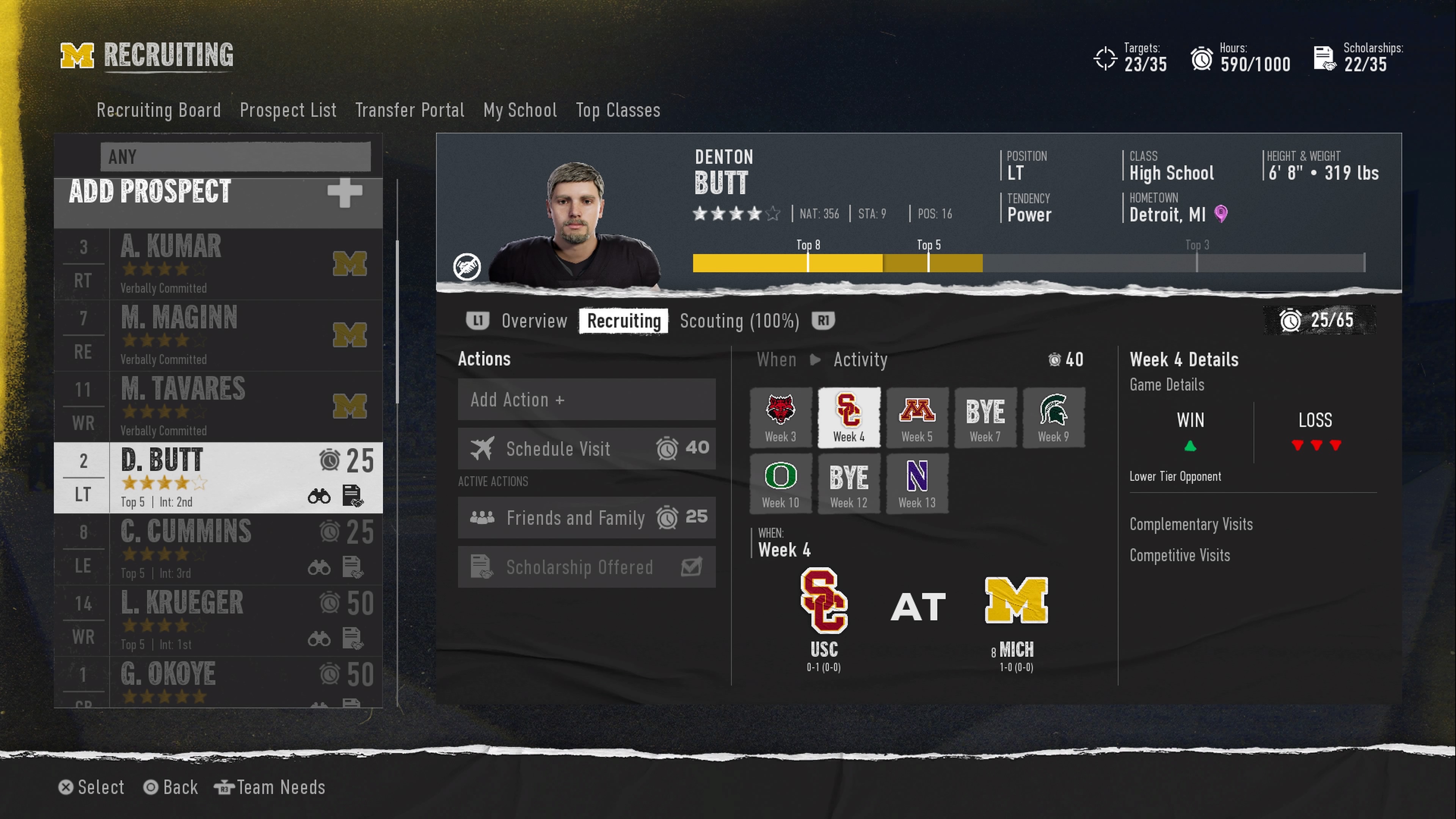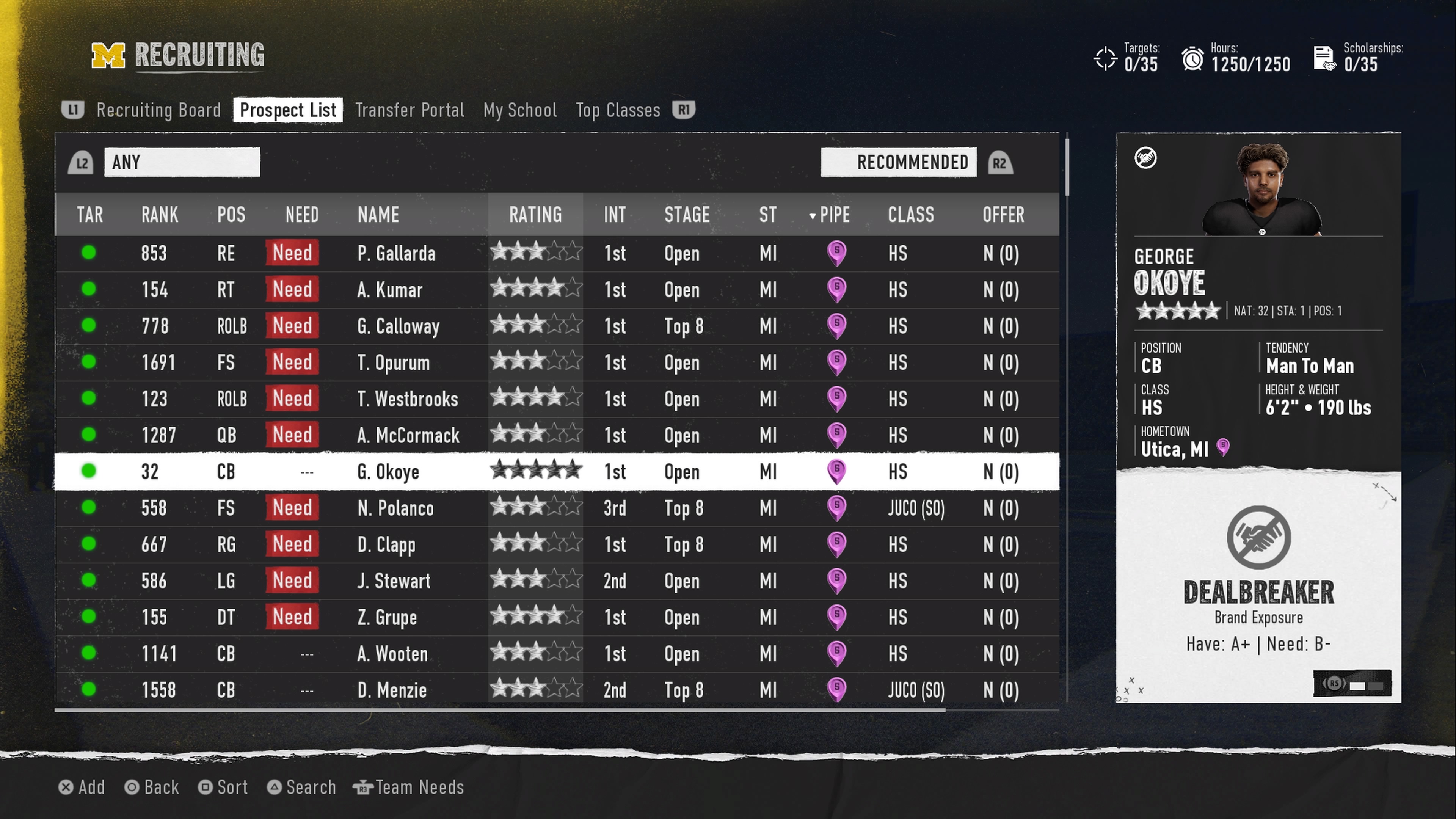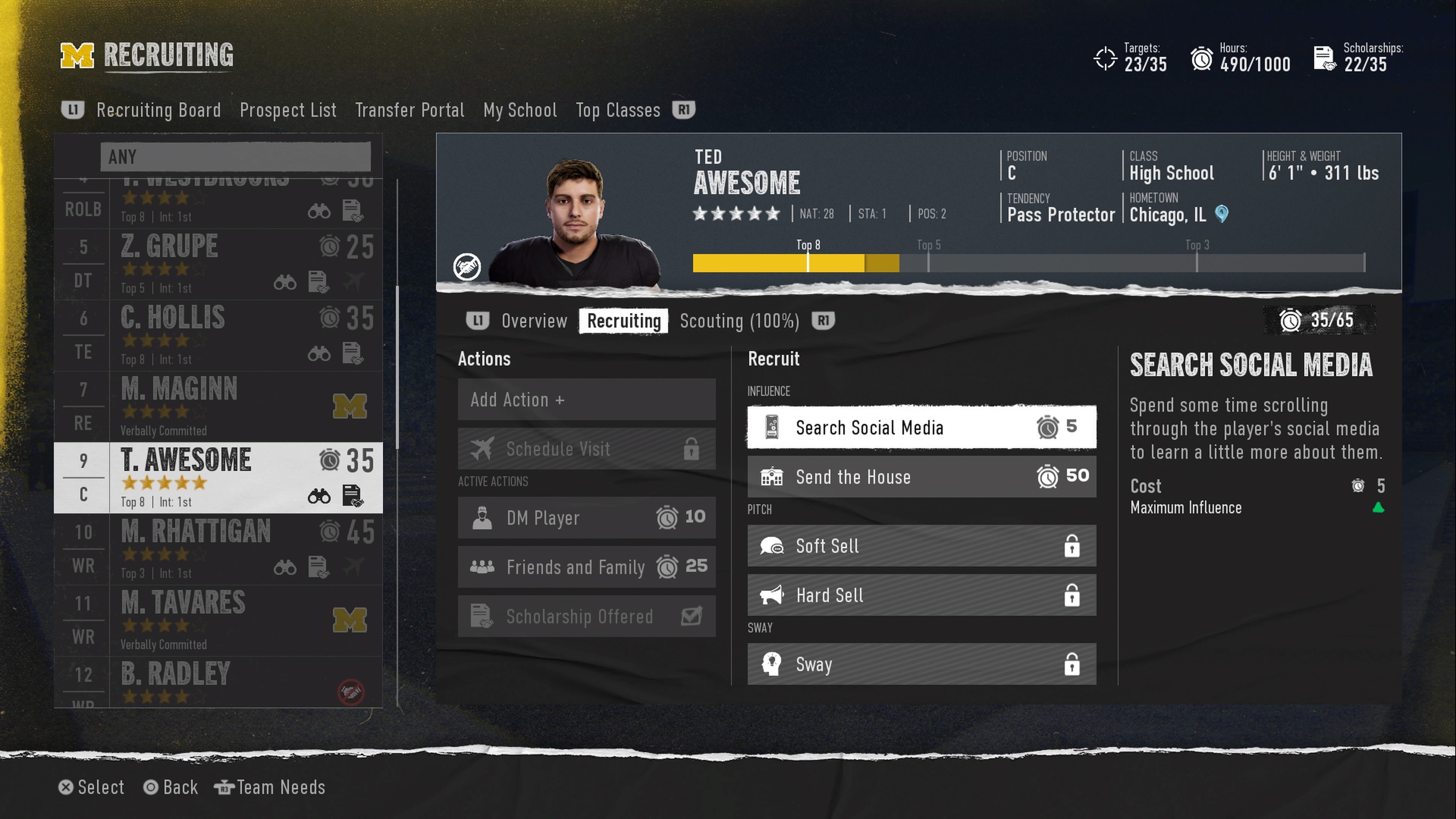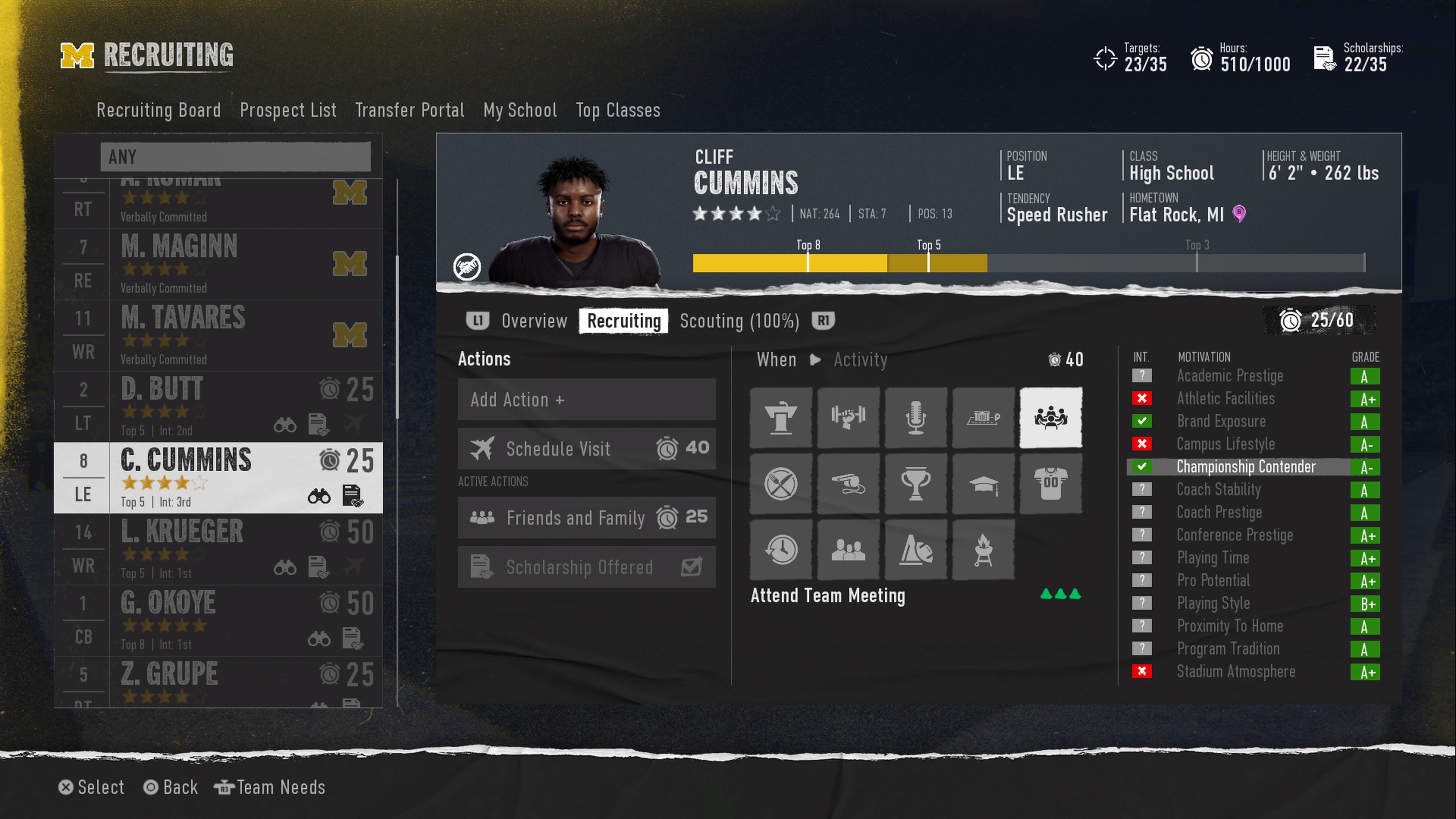College Football 25 recruiting guide for Dynasty mode
Grab the best high school prospects with our College Football 25 recruiting guide

Our College Football 25 recruiting guide is essential if you're suffering withdrawal symptoms following the end of the season. College Football 25 is GR's sports game of the year, and there's still time to kick off a dynasty mode and rewrite your team's wrongs from the last campaign. Its most addictive feature is recruiting. Below we explain the best ways of attracting elite talent to your squad, with GR+'s College Football 25 recruiting guide.
College Football 25 recruiting basics

EA focussed on three pillars when it came to building the high school recruitment model in Dynasty Mode. It’s worth you knowing these from the outset, as they all play into whether a hot prospect is willing to join your program:
- Recruits have unique needs and motivations that you have to discover by interacting with them individually.
- Regions of the country are differentiated by player caliber, quality, and type to authentically capture high school talent based on historical real-world data.
- The different resources available mean the top schools blanket the country, while smaller schools need to be more targeted.
Your College Football 25 recruiting board

At that start of each season you begin to populate your recruiting board. There are more than 3,500 players to choose from, so it’s worth investing some time on this initial groundwork. Go old school and have a pen and paper handy too!
The first thing to look for is five-star prospects who also have a pipeline rating of 5. These should be your number one priority, particularly in positions of need. Some may even sign as soon as you offer a scholarship. From here, look for four-star prospects with a 5 pipeline rating, or five-star prospects with a 4 pipeline rating. Follow this down to three-star prospects with a 5 pipeline rating, and so on.
As you play you’ll develop nuances to your searches, such as height, weight and other subtle differentiators, but this advice is an excellent starting point.
The maximum number of players on your board is 35. As the weeks advance, note down each prospect’s three key motivations, some of which are Deal Breakers. You want to make sure your recruit aligns with your strongest points on the grades list below. Any with desires for which you only have B or C grades may need to be immediately removed from your board. But that’s up to you!
College Football 25 recruiting hours

Once the season is underway, you need to commit hours to winning over your recruits. While you’re doing this, prospects gradually narrow down their top schools from Open, to Top 8, Top 5, Top 3, and finally Commitment. Your priority is to stay above their cut-off line each week.
Recruiting hours are based on your team’s prestige. A five-star college starts out with 1,000 hours, while a one-star school gets just 350. Also, you can only spend 50 hours on a single prospect, unless you have the Always Be Crootin’ ability. This grants 70 hours at specific positions.
Here’s a list of what you can do with those 50 hours, for each prospect:
- Scout - 10 hours (usually takes three sessions to full scout one player)
- Offer Scholarship - 5 hours
- Search Social Media - 5 hours
- DM The Player - 10 hours
- Contact Friends and Family - 25 hours
- Send The House - 50 hours
- Soft Sell - 20 hours (only available when in recruit has chosen top five schools)
- Hard Sell - 40 hours (only available when in recruit has chosen top five schools)
- Sway - 30 hours (only available when in recruit has chosen top five schools)
- Schedule Visit - 40 hours (see the final point of this guide)
College Football 25 recruiting school grades

Your school grades are vital in attracting prospects. There are 14 in total. Most can be improved – or get worse – as you progress, meaning results really do matter. When you talk to players or bring them in for visits, try to match your strengths with theirs, using the color coded symbols. Green is good, red is a no-go!
- Playing Time: How long it will take for a player to become a starter in your college.
- Playing Style: A representation of how you play. For example, Field General quarterbacks' 'playing style' grade is dictated by passing yards per game.
- Championship Contender: How close your team is to winning a championship, based on current rankings.
- Program Tradition: Historic success based on Championships, wins, and awards.
- Campus Lifestyle: A rating of the area surrounding the campus, and campus itself. This grade cannot be changed.
- Stadium Atmosphere: This is set according to the stadium’s Toughest Places to Play ranking, which is based on home wins.
- Pro Potential: How likely it is that players on the current roster will make it to the NFL.
- Brand Exposure: A team’s overall brand recognition.
- Academic Prestige: How good your school is academically. This grade cannot be changed.
- Conference Prestige: The overall strength of the conference your college plays in.
- Coach Prestige: How good the school’s coaching staff is, especially the Head Coach.
- Coach Stability: How long the coaching staff has been in place and is likely to keep their jobs over four years.
- Athletic Facilities: The quality of athletic facilities for the program.
- Proximity to Home: Where your school is in relation to the recruit’s home pipeline.
College Football 25 schedule visit and securing a prospect

As the season unfolds, the final element of securing your target is the Schedule Visit option. This costs 40 hours from your overall team allocation, but doesn’t count against the 50 individual hours. It’s only available once a prospect has finalised his top five, and been offered a scholarship by your school.
You can host up to four prospects per visit, and they’re only available for home games or bye weeks. There are 14 activities to choose from. Again, try to marry up a prospects’ three interests with your strengths! Also think carefully about positions. Bringing two QBs in on the same day is likely to put one or both off, due to them being in direct competition. However, a QB and LT pairing might develop chemistry. Also, be sure to win the match in question!
Once your prospects have verbally committed, it’s all about maintaining your promises until signing day. For instance, if they have Championship Contender as a Deal Breaker and you lose five games on the spin, there’s a risk of losing them. Hopefully that doesn’t happen and, once signing day is done, you can relax and start busting out some College Football 25 celebrations. Until the whole process begins again to start the next season…
Sign up to the GamesRadar+ Newsletter
Weekly digests, tales from the communities you love, and more
I'm GamesRadar's sports editor, and obsessed with NFL, WWE, MLB, AEW, and occasionally things that don't have a three-letter acronym – such as Chvrches, Bill Bryson, and Streets Of Rage 4. (All the Streets Of Rage games, actually.) Even after three decades I still have a soft spot for Euro Boss on the Amstrad CPC 464+.



